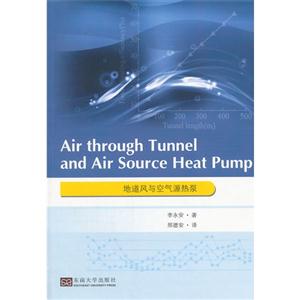掃一掃
關注中圖網(wǎng)
官方微博
本類五星書更多>
-
>
了不起的建筑師
-
>
勝景幾何論稿
-
>
中國古代建筑概說
-
>
維多利亞:建筑彩繪
-
>
庭院造園藝術——浙江傳統(tǒng)民居
-
>
建筑園林文化趣味讀本
-
>
磧口古鎮(zhèn)
地道風與空氣源熱泵 版權信息
- ISBN:9787564157142
- 條形碼:9787564157142 ; 978-7-5641-5714-2
- 裝幀:一般膠版紙
- 冊數(shù):暫無
- 重量:暫無
- 所屬分類:>>
地道風與空氣源熱泵 本書特色
本書是住房和城鄉(xiāng)建設部科研課題,對冬夏季地道風的特性及基于地道風的空氣源熱泵進行了較為深入的研究,取得了一批具有實用價值的成果,主要內(nèi)容包括地層溫度的變化特點與計算、地道中空氣與土壤之間的換熱、空氣流經(jīng)地道的加熱過程、空氣流經(jīng)地道的冷卻過程、基于地道風的空氣源熱泵等。
地道風與空氣源熱泵 內(nèi)容簡介
本書是住房和城鄉(xiāng)建設部科研課題,對冬夏季地道風的特性及基于地道風的空氣源熱泵進行了較為深入的研究,取得了一批具有實用價值的成果,主要內(nèi)容包括地層溫度的變化特點與計算、地道中空氣與土壤之間的換熱、空氣流經(jīng)地道的加熱過程、空氣流經(jīng)地道的冷卻過程、基于地道風的空氣源熱泵等。
地道風與空氣源熱泵 目錄
Chapter 1 Introduction 1.1 Current situation of energy source in China 1.2 Utilization of renewable energy resource 1.3 Traditional utility pattern of air through tunnel(hereafter referred to as\"ATT\") Chapter 2 Characteristic of Formation Temperature Change 2.1 Source of formation energy 2.1.1 Solar radiation energy 2.1.2 Biological heat 2.1.3 Geothermal resources 2.2 Thermo—physical property of formation soil 2.2.1 Heat conductivity coefficient λ 2.2.2 Specific heat cP 2.2.3 Thermal diffusivity α 2.3 Change rules of soil temperature inside formation 2.4 Numerical mathematical model for original soil temperature field 2.4.1 Dynamic model of shallow underground soil temperature distribution 2.4.2 Solve the shallow formation soil temperature distribution in application of Fourier Law 2.5 Characteristic analysis of formation temperature wave 2.5.1 Formation soil temperature attenuating property 2.5.2 Temperature wave delay 2.5.3 Calculation of original formation soil temperature at the same time Chapter 3 Heat Transfer between Soil and Air in Tunnel 3.1 Analysis of tunnel wall heat conduction process 3.2 Introduction of coupling problem 3.3 Selection of turbulence model 3.4 Processing of near—wall region 3.5 Mathematical description of the model 3.6 Mesh generation of mathematical model 3.7 Definition of boundary conditions in GAMBIT and FLUENT 3.7.1 Settings for boundary conditions 3.7.2 Preliminary defining of the types of boundary conditions in the GAMBIT 3.7.3 Further defining the conditions of the mathematical model in FLUENT Chapter 4 Process Analysis of Air through Tunnel in Summer 4.1 Determination of different parameters in simulation computation 4.1.1 Air outdoor meteorological parameters 4.1.2 Formation temperature 4.1.3 Tunnel masonry material 4.1.4 Convection heat transfer coefficient 4.2 Analog computation and analysis of all factors for air cooling through tunnel 4.2.1 Simulation computation and analysis for air cooling factors through tunnel under 4.2.2 Dynamic simulation computation and analysis of air temperature drop through tunnel 4.3 Tunnel cooling efficiency 4.3.1 Effect of tunnel length on tunnel cooling efficiency 4.3.2 Effect of tunnel buried depth on tunnel cooling efficiency 4.3.3 Effect of tunnel wind speed on tunnel cooling efficiency 4.3.4 Effect of tunnel structure size on tunnel cooling efficiency 4.3.5 Effect of different ventilation time on tunnel cooling efficiency Chapter 5 State Change of Air through Tunnel in Winter 5.1 Introduction of mathematical model 5.1.1 Model zone setting 5.1.2 Air outdoor meteorological parameters 5.1.3 Formation temperature 5.1.4 Soil physical property parameters 5.1.5 Determination of convection heat transfer coefficient 5.2 Simulation results 5.3 Analog computation and analysis of all factors for air heating through tunnel 5.3.1 Simulation computation and analysis for air heating factors through tunnel under steady state 5.3.2 Dynamic simulation computation and analysis of air temperature drop through tunnel 5.4 Tunnel heating efficiency 5.4.1 Effect of tunnel length on tunnel heating efficiency 5.4.2 Effect of tunnel buried depth on tunnel heating efficiency 5.4.3 Effect of tunnel wind speed on tunnel heating efficiency 5.4.4 Effect of tunnel structure size on heating efficiency Chapter 6 Air through Tunnel Experimental Study 6.1 Experimental object description 6.2 Experimental methods and apparatus 6.2.1 Conditions preparation before the experiment 6.2.2 Experimental methods and procedures 6.2.3 Experimental apparatus 6.3 Experimental error analysis 6.3.1 Experimental apparatus error analysis 6.3.2 Error analysis of experimental measurement 6.4 Experimental procedures and data processing 6.4.1 The experimental procedures and results of tunnel parameters measurement under original state 6.4.2 Experimental procedures and results of each measured parameters inside the tunnel under ventilation state 6.5 Comparative analysis of experimental results and theoretical calculation Chapter 7 ASHP 7.1 Heat pump and its type 7.2 Air source heat pump(ASHP) 7.3 The characteristics of ASHP 7.4 The applicability of ASHP Chapter 8 Air Source Heat Pump Based on Air through Tunnel 8.1 Air source heat pump based on air through tunnel 8.2 Introduction of ASHP experimental system based on air through tunnel 8.2.1 Work principle of ASHP system based on ATT 8.2.2 Experiment facility and test method 8.3 Experiment data and analysis of ASHP based on ATT 8.4 Frostless ASHP based on ATT 8.5 Application analysis of ASHP based on ATT 8.6 Innovation analysis of ASHP based on ATT Annex Annex 1 Surface Temperature,Temperature Wave Amplitude,and Maximum Depth of Frozen Ground of Main Cities in China Annex 2 Calculating Parameter for Building Material Thermo Physical Characteristic
展開全部
書友推薦
- >
李白與唐代文化
- >
隨園食單
- >
煙與鏡
- >
唐代進士錄
- >
有舍有得是人生
- >
經(jīng)典常談
- >
莉莉和章魚
- >
姑媽的寶刀
本類暢銷
















